Indian Democracy at Cross-roads 7: Indira Gandhi’s Conflict with Congress Veterans that led to the F
By Dr Eugene DSouza, Moodubelle
Bellevision Media Network
|
In spite of these predictions, one cannot underestimate the regional parties who collectively can topple the applecart of the NDA by coming together on a common platform in the form of a Third Front. But one cannot forget the previous experiments with such a possibility as each of the regional leaders entertain an ambition of becoming Prime Minister. Hence, their efforts would be to win the maximum number of seats so that they could have bargaining power to put forward their own claim for the Prime Ministerial Chair.
A lot of churning is going on in the political ocean as alliances are being formed and disgruntled ticket-losers in one party jumping the bandwagon of other parties. As winning is the prime ‘mantra’ of all political parties, they are in the process of fielding candidates with criminal background and corrupt practices. The general election of 2014 has been generating a lot of heat and dust. As such it would be interesting to be a witness to the historical event by understanding the forces and personalities that shape the future of this great country. Bellevision.com would bring out analytical articles by experts on the forthcoming elections that would provide insight into the historical general election of 2014. - Bellevision.com Team
|
4 April 2014: As I had mentioned at the end of the last installment of ‘Indian Democracy at Cross-roads 5’, the echo of Narendra Modi’s attempt to consolidate his hold over the party and prime ministerial claim by sidetracking BJP veteran leaders can be found in the pages of history when Mrs. Indira Gandhi in her endeavour to gain preeminent position in the Congress had a running feud with Congress veteran leaders of the time which eventually led to the first major split in the Indian National Congress.
Following the death of Jawaharlal Nehru on 27 May 1964, Lal Bahadur Shastri was elevated to the position of Prime Minister of India on 9 June 1964, chiefly due to the efforts of the then Congress Party President, K. Kamaraj. Being mild-mannered and soft-spoken Nehruvian and socialist, Shastri had an appeal to those who wished to prevent the capture of political power at the center by conservative right-wing elements led by Morarji Deasai.
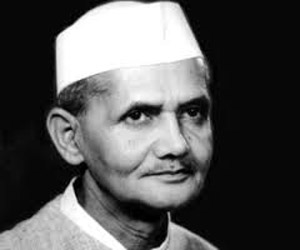
Lal Bahadur Shastri
Lal Bahadur Shastri’s tenure as the prime minister was brief as he died at Tashkent on 4 January 1966 where he had gone to sign the Tashkent Declaration with General Ayub Khan, president of Pakistan following the end of the Indo-Pak conflict of 1965. As the news of the death of Shastri reached Delhi, Gulzarilal Nanda once again assumed the role of the Acting Prime Minister until the Congress Parliamentary Party elected Mrs. Indira Gandhi over Morarji Deasi to officially succeed Lal Bahadur Shastri as the Prime Minister of India (Gulzarilal Nanda first time became Acting Prime Minister following the death of Jawaharlal Nehru in May 1964).
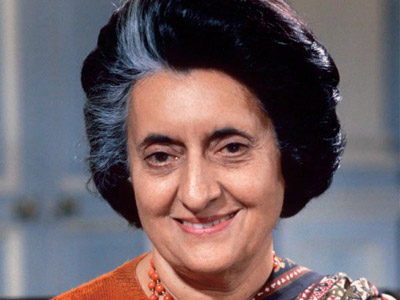
Mrs. Indira Gandhi
Mrs. Indira Gandhi as Prime Minister:
The sudden death of Lal Bahadur Shastri brought to the forefront the struggle for power within the Indian National Congress(INC). Having lost earlier, Morarji Desai staked his claim to the top post in the country. However, the Syndicate comprising of veteran Congress leaders, which had aversion to Morarji Desai, decided to bypass his claim and looked around for someone whom they thought would be able to control.
The choice of the Syndicate was Mrs. Indira Gandhi. She was quite qualified to the high post. Being Nehru’s daughter, she had an all-India appeal and a progressive image. Although married to another Congress MP, Feroze Gandhi (died in 1960), for many years Mrs. Gandhi had lived with her father as his hostess and closest companion. In the public eye she was the person most closely associated with his legacy. She had a gradual rise in the Congress hierarchy. In 1959 she had been elected president of the party. However, Nehru had consistently refused to give her a position in the government. The Syndicate was, thus, shrewd in its choice of Mrs. Gandhi as the next prime minister. While she inherited the Nehru legacy, she was an inexperienced and young woman, and they thought that she would be dependent on them for her policies and administration.
The succession of Mrs. Gandhi was stage managed by Kamaraj. Twelve out fourteen chief ministers supported her. As Morarji Desai insisted on contesting the election as the leader of the Congress Parliamentary Party (CPP), a secret ballot in the CPP was held on 19 January 1966. Mrs. Gandhi polled 355 votes and defeated Desai who polled only 169 votes. Thus, Mrs. Gandhi became the first woman Prime Minister of India.
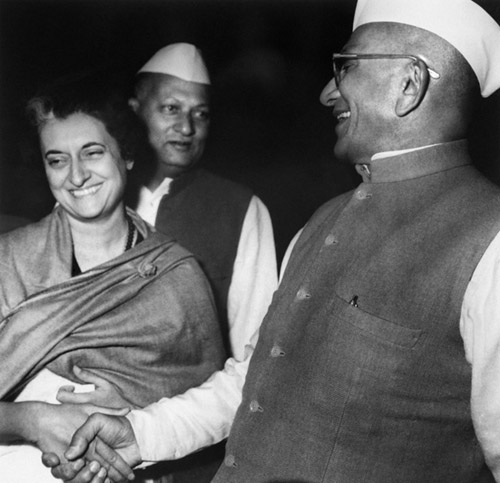
A file photo of Indira Gandhi and her opponent Morarji Desai just after her election as Prime Minister of India, 19 January 1966.
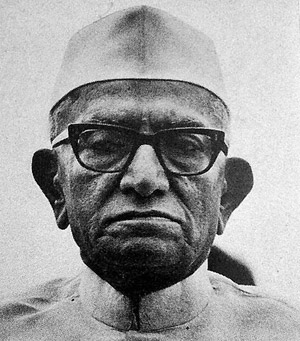
Morarji Desai
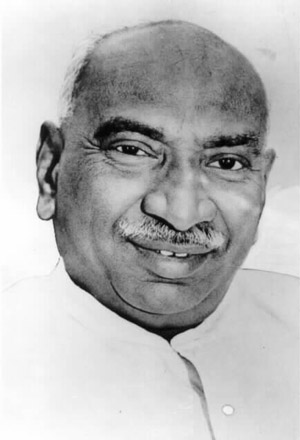
K. Kamraj
Decline in Congress Popularity:
The fourth general elections to the Lok Sabha and the state assemblies were held in February 1967. This election witnessed a sharp decline in the popularity of the Congress party. Though the Congress party succeeded in retaining control of the Lok Sabha, its seats were reduced from 361 to 284 out of 520. In West Bengal and Kerala the left parties were successful. The loss of Congress was translated into gains for the communal, feudal, right wing and regional parties. Congress lost its majority in eight states (Bihar, U.P., Rajasthan, Punjab, West Bengal, Orissa, Madras and Kerala). Both Jana Sangh and the Swatantra party made substantial gains both in the Parliament and state assemblies. This election signaled the end of the massive majorities of the Nehru era. It was a clear sign that the Congress was losing its hold over the Indian electorate.
Coalition Governments and Politics of Defection:
Two of the important features of the 1967 elections were the experiment in short-survived coalition governments and the politics of defection. Except in Tamil Nadu, where the Dravida Munnetra Kazagham (DMK) party formed the government, coalition governments were installed in other states. In Punjab, Bihar and U.P., opposition governments included Swatantra, Jan Sangh, Bharatiya Kisan Dal (BKD), Socialists and Communist Party of India (CPI). Congress also formed coalition governments in some of the states where it had been reduced to minority. Except the DMK government in Tamil Nadu and the Swatantra-led Government in Orissa, the coalition governments in other states proved to be highly unstable and could not survive for long. The Council of Ministers became unwieldy, shifting loyalties for money and power became common and the political defection was adopted to destabilize governments and form new governments promising ministerial berths or other incentives to the defected members.
Weakening of the Syndicate:
The 1967 elections drastically changed the balance of power within the Congress. The Syndicate received a major blow as several of its members, including Kamaraj, Atulya Ghosh and S.K. Patil lost the election. Most of the loyal followers of the Syndicate also failed to get elected to the Parliament and the state assemblies. Under these circumstances, the position of Mrs. Gandhi within the party was strengthened. She asserted her position as the leader of the Congress Parliamentary Party and manifested her freedom in the choice of ministers and distribution of portfolios. Morarji Desai, who had not given up his dream of becoming the prime minister of India, after a compromise accepted the position of deputy prime minister in the cabinet with the portfolio of finance.
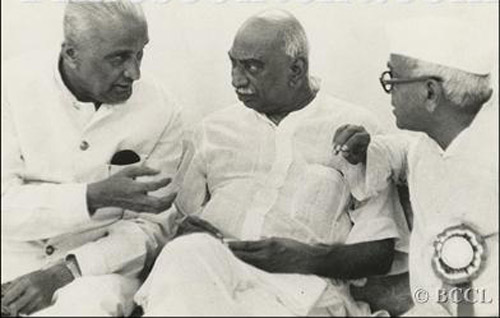
Congress leaders S K Patil (left), K Kamaraj and C B Gupta (right)

Atulya Ghosh
Ten-Point Programme:
Ideological differences between the two factions within the Congress, the right wing Syndicate and the left-of-the center group led by Mrs. Gandhi widened the gulf between the two. Soon after the elections of 1967, two issues became significant. First was dealing with the growing popular protests accompanied by violence, and the second was regaining the popular support to the party that was on the decline.
The two factions within the party were broadly divided ideologically not only in dealing with these issues but also regarding the future economic and political policies that the party should adopt. The general mood within the Congress immediately after the setback in the 1967 elections was to tilt to the left. In May 1967, the Congress Working Committee adopted the radical Ten-Point Programme. It included the social control of banks, nationalization of General Insurance, state trading in import and export trade, ceilings on urban property and income, restrictions on business monopolies and concentration of economic power, public distribution of food grains, rapid implementation of land reforms, provision of housing-sites to the rural poor, and abolition of princely privileges.
However, the right-wing Syndicate in the Congress began to assert itself and openly promoted right-wing policies such as dilution of planning in economic field, encouragement to private sector and foreign capital, and suppression of the left and protest movements, especially those of the rural poor in order to get the support of the rich peasants and large landowners.
Struggle for Power Between the Syndicate and Mrs. Gandhi:
The struggle for power within the Congress was coming to a head. Though Mrs. Gandhi headed the government, the party organization was beyond her influence as the Syndicate controlled it. On Kamaraj’s retirement as the president of the Congress at the end of 1967, Mrs. Gandhi’s attempt to have a friendly person to head the party was foiled by the Syndicate, and the post went to the conservative, Nijalingappa. She even failed to get some of her people elected to the Congress Working Committee.
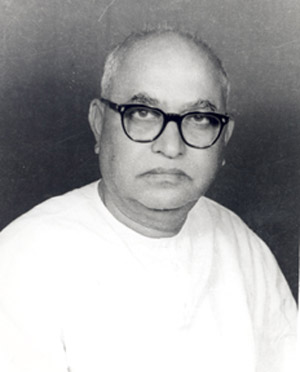
S. Nijalingappa
Meanwhile, between 1968-69, the Syndicate began to conspire to dislodge Mrs. Gandhi from the office of the prime minister. The Syndicate members roped in Morarji Desai, their old foe in this plot. In spite of these developments, Mrs. Gandhi followed caution. She did not want to jeopardize the unity of the party and the stability of her government at that juncture. Thus, she tried to avoid any open conflict and a split in the Congress and accommodated the Syndicate and Morarji Desai in both cabinet making and policies, which the Syndicate had been asserting. However, when she faced a direct challenge to her position, Mrs. Gandhi decided to fight back.
Differences Over Presidential Election (1969):
The unexpected death in office President of India, Zakir Hussain in May 1969 once again fuelled the struggle that was already in progress. The Syndicate was keen to have their own nominee occupy the president’s post. The All India Congress Committee (AICC) in its meeting at Bangalore in July, 1969, in spite of Mrs. Gandhi’s opposition, nominated Sanjiva Reddy, a prominent member of the Syndicate, as the Congress candidate for presidentship.
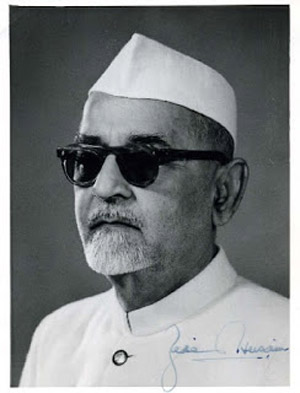
Zakir Hussain
Fearing the designs of the Syndicate to oust her from office by using Sanjiva Reddy’s presidency, Mrs. Gandhi decided to carry the battle to the opponent’s camp. Projecting her radical ideology, within few days of the Bangalore meeting, she deprived Morarji Desai of his finance portfolio and took it under her charge. Her argument was that as a conservative he was not capable of implementing her radical programme. Desai resigned from the cabinet. Not stopping at this, through presidential ordinance, Mrs. Gandhi nationalized fourteen major banks in July 1969, and also announced her plan to withdraw the special privileges of the princes. Within short period, Mrs. Gandhi was perceived as the champion of the masses and her popularity went up. However, the Syndicate was bidding for time till the election of Sanjiva Reddy, the official candidate of the Congress as the president in order to settle scores with Mrs. Gandhi.
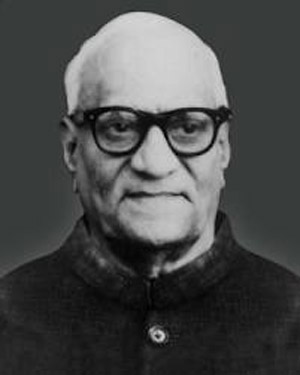
V.V. Giri
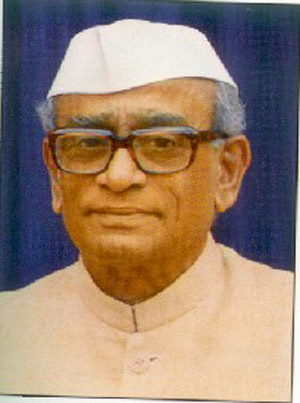
Neelam Sanjiva Reddy
Election of V.V. Giri as the President: In the presidential election Mrs. Gandhi decided to play her game as shrewdly as possible. There were three presidential candidates. Besides the official Congress candidate, Sanjiva Reddy, there were other two in the fray; C.D. Deshmukh supported by the Swatantra Party and Jan Sangh, and V.V. Giri, the Vice-President, who had decided to contest the presidential election as an independent candidate, supported by the Communist and other parties. The Syndicate committed a tactical error when Nijalingappa approached the Jan Sangh and Swatantra leaders requesting second preference votes in his favour in order to ensure his election. This gave an excuse to Mrs. Gandhi to accuse the Syndicate of joining hands with the communal and reactionary forces to oust her from office. She decided to support V.V. Giri and asked the Congress MPs and MLAs to vote according to their ‘conscience’, rather than issuing a whip in favour of the Congress candidate. The election results proved that nearly one-third of them defied the organizational leadership and voted for V.V. Giri, who won the presidential contest with a narrow margin on 20 August 1969.
Congress Split (1969):
Following the defeat of the official candidate of the Congress, the Syndicate decided to strike back at Mrs. Gandhi. The Congress President, Nijalingappa issued notices to Mrs. Gandhi, Jagjivan Ram and Fakhruddin Ali Ahmed, asking them to explain why action should not be taken against them. Y.B. Chavan played the role of a peacemaker and a unity resolution was passed by which an attempt was made to bring about reconciliation between the two groups. However, this and other efforts could not bridge the gap between the two. As days passed the standoff between the two factions of the Congress took serious turn. The Syndicate was vanquished in the presidential election, but was not destroyed.
The defeated and humiliated Syndicate in a final bid to salvage its reputation took disciplinary action against Mrs. Gandhi and on 12 November 1969, expelled her from the party accusing her of having violated party discipline. Thus, the Congress party finally split. Mrs. Gandhi’s faction of Congress came to be known as Congress (R), stood for ‘Requisitionists. The Syndicate faction of the Congress came to be known as Congress (O), ‘O’ stood for ‘Organization’. The breakup of the Congress was completed on 22 and 23 November 1969, when the Congress (R) held its session in New Delhi under the presidentship of Subramanian. Out of 801 members of the undivided All India Congress Committee (AICC), about 495 attended this session. The Committee passed a resolution removing Nijalingappa from the presidentship of the Congress and temporarily elected Subramanian in his place. After a few weeks, Jagjivan Ram succeeded Subramanian as the president of the Congres (R).
In spite of her clear victory over the Syndicate and rising popularity among the people, Mrs. Gandhi lacked political strength, as her party did not command majority in the Parliament. Among the original Congress MPs, 68 were still with the Syndicate. Hence, her government was in minority and she was dependent on issue-based support by the two Communist parties, some Socialists, DMK, Akali Dal and some independents.
General Elections of 1971:
Because of the nature of the minority government, Mrs. Gandhi felt that she had to depend on other parties to get some of the progressive legislations passed in the Lok Sabha. She was waiting for an opportunity to dissolve the Lok Sabha and go to the polls. Such an opportunity came her way when the Supreme Court struck down her attempt to abolish the privy purses of princes. On 27 December 1970, Mrs. Gandhi recommended the President, V.V. Giri to dissolve the Lok Sabha and elections were ordered to be held in February 1971, one year ahead of time.
In order to win popular support, Mrs. Gandhi announced a number of socialist policies which she knew would appeal to the masses. The most important of these were abolition of the privy purses enjoyed by the princes and the nationalization of the banks. The results of the 1971 elections were an overwhelming victory for Mrs. Gandhi, and the Congress (R) won a two-thirds majority in the Lok Sabha with 352 out of 518 seats. Mrs. Gandhi received the mandate she had sought, and she became the unchallenged leader of the Congress and a dominant political figure in the country.

Indira Gandhi acknowledges supporters during the 1971 elections
Having emerged as the undisputed leader in the Congress in particular and in the country in general, Indira Gandhi seemed to be invincible with overwhelming support both within the parliament and outside. She became the darling of the nation when she declared war on Pakistan following a pre-emptive air strike by Pakistani air force on 11 Indian airbases on 3 December 1971. Thus, the Bangladesh freedom movement merged with the Indo-Pak War that just lasted for 13 day with the defeat of Pakistan and liberation of Bangladesh. India was hailed as the liberator of Bangladesh.
.jpg)
A tale of two agreements: On December 16, 1971, India’s victory over Pakistan got translated into black and white when the then Army Commander, Lt. Gen JS Aurora accepted the instrument of surrender from Pakistan at the Ramna race course, Dhaka. Seven months down the line (below), in Shimla, many feel we signed it all away by helping Pak President ZA Bhutto not get ’lynched’ in return of unwritten commitments which, obviously, were never met
.jpg)
Indira Gandhi could not bask in the glory of the victory over Pakistan for a long time. Opposition to her authoritarian regime was growing all around. On 12 June 1975, the Allahabad High Court invalidated the result in Indira Gandhi’s constituency Rae Bareli on the grounds of electoral malpractices. Instead of resigning, Indira Gandhi declared a State of Emergency suspending democracy and outlawing political opposition. This was the dark period in Indian democracy where Indira Gandhi ruled the nation for nearly two years from 1975 to 1977 in a dictatorial manner. However, after the lifting of emergency, restoration of democracy and declaration of election in 1977, Indira Gandhi and her Congress party lost the election. The opposition formed a coalition of parties called the Janata Party which formed the government that too lasted for merely two years from 1977 to 1979.
Will History Repeat Itself...?
Will history repeat itself and see Narendra Modi who has been sidelining the BJP veterans score a brilliant electoral victory with two-thirds majority in the 16th Lok Sabha on his ‘Development’ mantra? Compared to Mrs. Indira Gandhi’s struggle against the conservative old guard (Syndicate) in the Congress, the task of Narendra Modi in sidelining the BJP veterans has been much easier as their number is quite less and their clout is insignificant. In fact Mrs. Indira Gandhi had a greater challenge as she had to suffer the split of the national party and rebuild her faction of Congress in spite of many odds and go into election. Fortunately for Narendra Modi, the entire BJP party has been solidly behind him and hence silencing the veterans has been much easier for him in comparison with Mrs. Indira Gandhi.
.jpg)
If the opinion polls are to be believed, BJP led NDA would emerge victorious in the coming Lok Sabha elections and Narendra Modi will definitely become the Prime Minister of India. What next…? Gradually, will he follow the example of Indira Gandhi and precipitate a conflict with India’s neighbours, especially Pakistan with a view of establishing ‘greater India’ and have a military showdown in the manner of the Indo-Pak War of 1971? In the same way, is the country preparing for an era of democratic dictatorship…? Well, history has many lessons…
(From various sources)
Also Read
- Indian Democracy at Cross-roads 3: Experiment in Coalition Politics-Rise and Fall of the Janata Gove
| Comments on this Article | |
| Benedict Noronha, Udupi / India | Fri, April-4-2014, 9:37 |
| It is a great history repeated by an Historian of Belle. the facts are true. the Humna nature is such that every one likes to be a leader. the basic phylosophy of serving to lead is not known . Hence gender fiasco and male domination lead to split in congress. Indiaji had best of education through her fathre and hence she was capable of manupoulating and winning the situation. The Present leaders must read the book discovery of India and mahatma Gandhiji s Biography. they will get good lessons to lead India. communalism and pulling one down to come up perhaps will not help. Younger generation is clever and play their role intelligently but for the communalism, youth of this country should do well to save democracy. Put in their best. come out , think freely , look for the future what they want. Can they think only of Hindutva or their own religion? No. they must think beyond and cast their Vote to the Beast of democratic leaders of their constituency, who has done well or see their history in Politics and and the leaders shown in this article and Vote. Fllow Dr Abdul Kalam s say. CAST Your Vote. Well done Dr. Eugene. Your history will open the eyes of the Youth. | |




 Write Comment
Write Comment E-Mail To a Friend
E-Mail To a Friend Facebook
Facebook Twitter
Twitter  Print
Print  There is a lot of speculation all-around regarding the possible outcome of the general election. It seems that the wind is clearly blowing in the direction of the Narendra Modi led BJP and the National Democratic Alliance (NDA) which is predicted to sweep the polls whereas the Congress led United Progressive Alliance (UPA) is being written off as the party and alliance that is doomed to utter failure.
There is a lot of speculation all-around regarding the possible outcome of the general election. It seems that the wind is clearly blowing in the direction of the Narendra Modi led BJP and the National Democratic Alliance (NDA) which is predicted to sweep the polls whereas the Congress led United Progressive Alliance (UPA) is being written off as the party and alliance that is doomed to utter failure.














